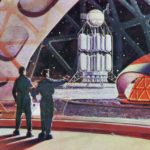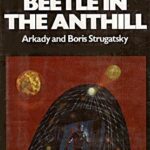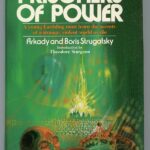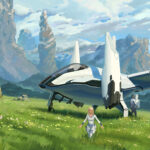Worlds from this series of books:
- Ark (Ковчег): described in Space Mowgli; a barren world very similar to Earth in all aspects except the biosphere. The latter is unbelievably poor: for example, the oceans of the planet are empty (no fish, no algae, no mammals) although quite suitable for protein life. This planet was chosen by progressors as a refuge and a new home for the population of Pant, a planet in danger of a global natural catastrophe. The name was given after the biblical Ark built by Noah. It was initially planned to gradually change the biosphere of Ark to make it more similar to the pantian one and then transfer all Pantians to their new home. Considering the low technological advancement level of Pantians, they should not have noticed anything at all. But this plan was canceled when the non-humanoid native civilization of Ark (Megaforms) was discovered. It isn’t stated anywhere in Strugatsky’s books whether the “Ark Project” (started in 2160 AD) was ever completed and how. The local civilization of Ark is nearly as enigmatic as Wanderers. An official contact with them was never established although the Ark Megaforms employed a human agent to communicate with progressors working on the surface of Ark. This agent was Piere “The Kid” Semyonov, a 13-year-old human whose parents died in 2147 when their spaceship “Pilgrim” was shot down by Wanderers’ satellite from a circular orbit of Ark. Although Megaforms negotiated (through their agent) to drive progressors away from their homeworld, no further attempt to share technologies or cultural developments was registered.
- Arkanar (Арканар)[2]
- Blue sands planet: the planet visited by the spaceship Taimyr, which returned in 2117.
- Earth (Земля)
- Garrota (Гаррота): the home planet of Garrotian snails (слизни Гарроты), a non-humanoid alien race that took humans and their technology for a product of their own imagination. This planet is briefly mentioned in “Space Mowgli“ and no further information about either the race or the planet is available.
- Giganda (Гиганда): a planet populated by humans whose technological advancement is roughly equal to that of Saraksh inhabitants. For a long time the two superpowers of the planet, Alai Duchy and the Empire, were drawn into a total war conflict that has been put an end to only when Earth‘s progressors started an undercover anti-war activity in 2177 AD. Apparently, no country possessed nuclear weapons. One of the planet’s natives, a foot soldier of the Alai Duchy was taken to Earth and introduced to its advanced society. Despite repeated efforts to integrate him, he failed to adjust. He was then returned to Giganda. Discovered in 2136 AD.
- Gorgona: the planet where the Stepchild Thomas Nielsen died in 2165, possibly a suicide.
- Hope (Надежда): described briefly in Beetle in the Anthill, it is another planet populated by humans whose technological advancement is roughly equal to that of Earth in the 20th century. Approximately in 2123 AD, a massive ecological catastrophe (probably, a man-made one) devastated the planet causing its inhabitants to age at an unnatural pace after the twelfth year of life. Wanderers, apparently believing that a new, clean environment is the cure, have transported most of the population of Hope to an unknown planet using some sort of enhanced null-T, but few people decided to remain and became a subject of a consequent hunt by Wanderers (through a sophisticated system of traps, especially for children). Discovered in 2162 AD
- Leonida (Леонида): the home planet of Leoniders, a humanoid alien race that lives in a perfect symbiosis with the planet’s biosphere. Leonida is located in EN-23 system, its only moon is called Palmyra (Пальмира) and its day-night cycle lasts a bit longer than 27 hours. This planet was apparently the first one with an Earth-like climate suitable for humans’ existence. Perhaps, the planet was named after its discoverer, Leonid Gorbovsky. Discovered in 2133 AD
- Mars: this solar planet featured in the Noon Universe. Mars bears complex forms of indigenous plant and animal life, though none sentient. It also bears many artifacts of an ancient supercivilization, assumed to be remnants of the Wanderers. An abandoned city sits at the North pole, and the moons Phobos and Deimos are discovered to be artificial satellites constructed by the Wanderers.
- Pandora (Пандора): is a planet wide holiday resort. It is mostly covered with jungle swarming with dangerous alien fauna (like crayfish-spiders or tahorgs) young people just love to hunt. Every year dozens of people are killed or seriously injured on Pandora despite countless safety measures by Earth’s government. No local sentient species registered. Pandora is apparently located in a system with two suns. Pandora’s skies were a training ground for Headies, when humans shared the space-traveling technologies with them during the “Headies in Space” project. Discovered before 2119 AD (exact date unknown)
- Pant (Панта): is a planet endangered by a global catastrophe – an explosion of its own sun as a part of standard stellar evolution. Unfortunately, there were sentient species identical to humans on the planet and so they had to be deported from it (“Ark Project”) to another one. The first choice was Ark but since the discovery of a sentient alien race there, progressors have apparently changed their mind. Discovered approx. in 2161 AD
- Rainbow (Радуга)
- Ruzhena (Ружена): an Earth-like planet in VK-71016 system. Valentin Petrov, the leader of the expedition that discovered it, named the planet after his wife, Ruzhena Naskova, but the planet wasn’t really hospitable: two members of the spaceship crew perished on it and Petrov himself lost an arm. Ruzhena is described in “Частные предположения”, a book that’s been never translated in English and contains only a vague connection to the Noon Universe
- Saraksh (Саракш)
- Saula (Саула)
- Tagora (Тагора): the home planet of Tagorians, a lizard-like alien race, the first one Earth‘s ever contacted with. It is mentioned in “An Attempt to Escape“ that there is a human resident (or spy) on Tagora whose name is presumably Benny Durov (Бенни Дуров) and he is a progressor working under cover to study Tagorian technology. Discovered in the end of 21st century although a full scaled contact was established in 2122 AD
- Tissa (Тисса): a planet in EN-63061 system. It is famous mostly for an incident that happened shortly after a FSG expedition discovered it. For some reason the members of the group couldn’t establish a radio connection to any human world or spaceship except for their own mothership on the orbit of Tissa, and its computers kept telling them that Earth and all other human settlements were destroyed by global catastrophes and that they are the only remaining humans in the Universe. After the group was rescued, psychologists decided that this was a case of temporary madness or a mass suggestion. Tissa is only mentioned in “The Time Wanderers“. Discovered in 2193 AD
- Vladislava (Владислава): the first planet (apart from Mars) where Wanderers‘ traces were found (artificial satellites and an abandoned city). Apart from that, the planet is known for its extremely turbulent atmosphere conquered only by famous Leonid Gorbovsky. Despite that, there is some protein life on the planet although no sentient one. Vladislava is located in EN-17 solar system. Discovered in 2121 AD
- Yaila (Яйла): an even harsher and more dangerous version of Pandora. Infamous for its monstrous fauna (e.g. Yaila Dragon, presumably, a reptilewith an enormous regeneration potential) and its impenetrable jungle and swamps it is considered by many to be just another planet-wide resort, but generally only the toughest and most experienced hunters dare to visit Yaila.
Details here and paragraphs here.
–
–
videos




